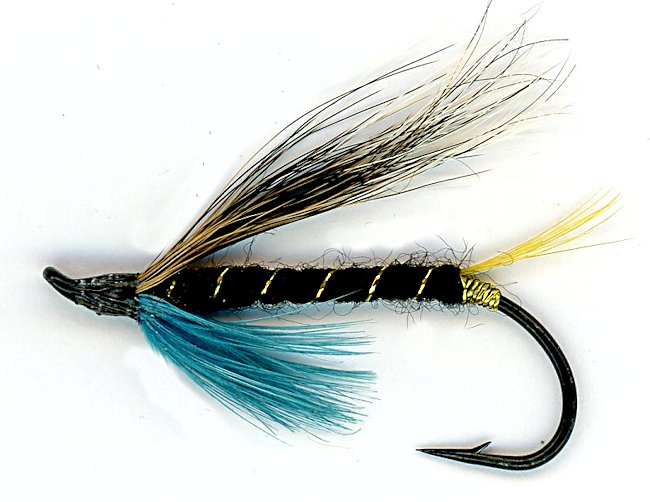The Blue Charm Hairwing Salmon Single Hook Fly
The Blue Charm is one of the old classic salmon flies that has retained its popularity because it gets results. It also catches Steelhead and has a good record as a Sea-trout fly.

SALMON AND STEELHEAD SINGLE HOOK FLY PATTERNS. Hook size 6 8 - $US each
Originally The Blue Charm Salmon Fly pattern was strongly associated with the river Dee in Scotland, but it crossed the Atlantic and has had incredible success on the North Eastern costal areas of North America. Now tired using modern materials it is widely used as a summer fly pattern on all rivers. Theoretically, blue flies appear more attractive in the blue light of the early morning. This fly was one of the first hair-wing patterns (known as the Hairy Mary in Britain). Originally tied in the 1950's by John Reidpath of Inverness, Scotland as a hairwing version of the traditional Blue Charm featherwing salmon fly. It is one of the earliest, simplest and most enduring of the hairwing patterns. We have it as a double and a tube fly as well as the single hook.
How do you catch a salmon using a Blue Charm single hook fly? When observing the River you may be lucky to catch a glimpse of the shadowy form of a salmon as it lies motionless in the water eroded River channel by a deep slab of rock. The only thing that seems to move are the regular breathing rhythms of its mouth and gills that betray presence whilst it holds position in the current. It seems to be asleep. It may have lain in in this location for a week or more. Since returning from the sea. It has long since ceased to eat. It's mind is on egg laying and reproduction. Its brain doesn't seem to register what is passing in front of it. On the face of it the task of catching one of these resting Salmons seems slightly unrealistic. How can you tempt a non-feeding fish to take your artificial salmon fly?
The answer is that you have to work your fishing fly in such a way as to trigger an instinctive attack response. Observe the River or obtain local knowledge as to where the best salmon lies on that particular stretch of water are located. Now you have to work your fly across those locations. Hopefully the salmon will soon notice your fly which it takes to be a small creature, upstream swimming across the current in a long, leisurely arc. This creature appears to swim away. After a few moments it appears again but this time closer. The salmon follows it with its eyes. It disappears again. Suddenly the same creature appears much nearer this time and swims into the salmon's vision just above its head. To the salmon this thing is invading its space. It is getting too close. The salmon leaves its safe resting place and follows the intruder. the last moment. It turns away without attacking.
A keen observant salmon fishermen, may have seen a boil near the fly, with the salmon showing it back or snout. That is the time to present fly again over the same location. Having already got the salmon's attention, this time, hopefully it will rise for an attack. To many fishermen do not pay attention to what is happening in the water around their fly. They have to train themselves to look out for subtle indicators that there are salmon investigating what is on the end of their fishing line. If your mind is on other things will miss those small tell-tale signs.
There is no formal proof method of taking a salmon in this situation. What you have is a set of options. Some or none may work, this depends on the mood of the salmon and the skill or luck of the flyfisherman. A slightly different style of presentation, may be all that is needed to get a hook up. Try retrieving more slowly and then try a faster retrieve. Another option is a dead drift over the holding location. If these tactics still do not bring success, I would suggest that a change of fly the good option. Try a smaller one of the same pattern. If you have been using a dark coloured fly then try one with a silver body.
I was fishing a Blue Charm hair wing salmon fly on my last Scottish fishing trip when I felt a nibble. I could see where my prey and retired to stop. I cast again and again with no luck. I tied on smaller hook size, but again no joy. I did not have any silver body flies left in my tackle box so I tied on an orange Ally's shrimp pattern. On my first cast there was a large splash as the salmon took my offering with gusto.
LINKEDIN COMMENT
One time while fishing near the town of Gaspe, I was on a low summer river and
I started with dry flies, then riffle hitched nymphs, and ended up hooking the salmon
on the swing with a small unweighted Blue Charm. I think the key was to change
tactics going from top to bottom. But, then again, the mystique is what makes me
come back again and again. Christopher P. Travis


Salmon fishing books

